Phantasma-what now?
Phantasmagoria is a mid-1995 PC point-and-click graphic adventure from the studio that essentially pioneered the genre: Ken and Roberta Williams’ Sierra On-Line. Written by Roberta, mastermind behind the wildly successful King’s Quest series, the game follows the grim adventure of novelist Adrienne Delaney and her husband Donald Gordon, who purchase a Victorian mansion in rural Massachusetts. Don is a photographer, and the locale offers him plenty of subject matter; Adrienne feels the rich history of the mansion, coupled with the cozy feeling their new, small town offers, will provide the perfect inspiration for her next hit novel. Not everything is as it seems in the old mansion however, and Adrienne soon finds herself facing situations that quickly escalate from somewhat creepy to quite horrifying.
The PC original exploited the then-relatively new FMV medium, overlaying actors on computer generated still backgrounds. With their King’s Quest success behind them, Sierra went all-out on Phantasmagoria. 25 live actors were cast and filmed blue-screen for the game; a professional director was hired to oversee the proceedings according to Williams’ 550 page (!) script. All-in, over 200 staff ended up working on the game at a time where a studio of a dozen heads was considered large. Complimenting the considerable cast of characters was over 1000 still backgrounds, which was multiple times what was common for graphic adventures of the time. Lastly, a 135-member choir recorded music to feature as part of the game’s OST. Initially budgeted at USD $800,000, Phantasmagoria wound up costing Sierra $4.5 million 1995 dollars to produce.
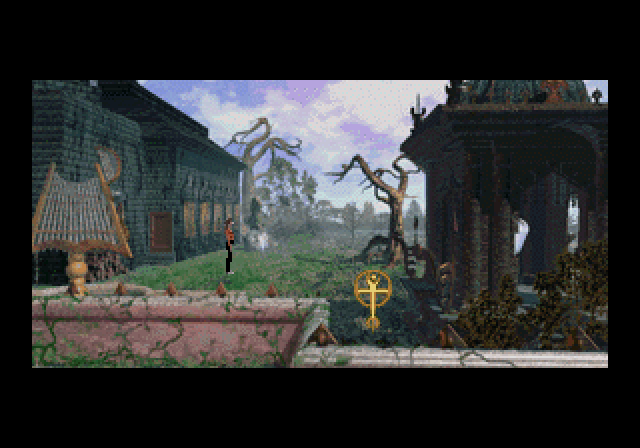
In the end, the gamble paid off. Backed by their impeccable name as a game studio as well as a strong marketing campaign and a fair share of controversy, the game was a financial success. On the week of release, the DOS and Windows game raked in over $12 million, and ended up on the 1995 best selling games list. To date, Phantasmagoria remains Sierra’s biggest title – outselling the publisher’s individual King’s Quest, Ultima, and Leisure Suit Larry releases.
Success didn’t come without a price, however. Rated ‘Mature’ for some frankly shocking depictions of violence, gore, sex, and even a relatively graphic rape scene (though the actors are not fully nude), the game picked up criticism from religious group and politicians, with some retailers refusing to carry the title at all. The game was outright banned in Australia and in Singapore, and every preview of the title mentioned ‘the rape scene’… all of this only adding to the game’s desirability amongst PC players.
… And then, the reviews started coming in.
Phantasmagoria’s reviews were all over the spectrum, with most landing in the mediocre. This was a surprise, with the big-budget title coming from the esteemed Sierra house and on the heels of the critically acclaimed King’s Quest games. Despite strong sales, the limited gameplay and easy puzzles, coupled with criticism for the shock violence the game depicts, ensured that Phantasmagoria was a one-hit wonder instead of the anthology of horror games that Sierra initially envisioned. A single sequel was quietly released the following year in 1996, though Roberta Williams was not involved, and the plot and characters were completely unrelated to the first game. While the first game was at least a commercial success, this was not the case for the second game, and just like that, the Phantasmagoria ‘franchise’ quietly died.
Or did it?
A year after the little-known sequel and two years – nearly to the day – since the Windows and DOS original, Infinity Entertainment Technology picked up and ported Phantasmagoria to the Saturn in Japan. Renamed ‘Phantasm’ and published by Outrigger in summer 1997, this was the one and only port of the game, ever. Spanning a record eight Saturn discs, this is an uncommon example of an English PC original getting the Japanese translation treatment, without the Saturn game also then being given a western release in the original English. The contemporary Saturn community eventually got their hands on it, and in mid-2022, the game was patched using the audio of the original game, and here we are – the only console port of a mid-90s PC game now available to play in English, on your SEGA Saturn!

The layout of the PC original is roughly two thirds video window, and one third dashboard / inventory section occupying the bottom portion of the screen. This gives the game a distinctly widescreen look. A small, yellow cursor-like symbol is the player’s interface with the game, turning red anytime the player hovers over a clickable area. Any aspects of the background which the player can move – an object, or a door, for instance – are little bits of video cleverly masked into the static background, ready to activate at the player’s click to give some life to the otherwise still scene. On the PC original this works reasonably well.
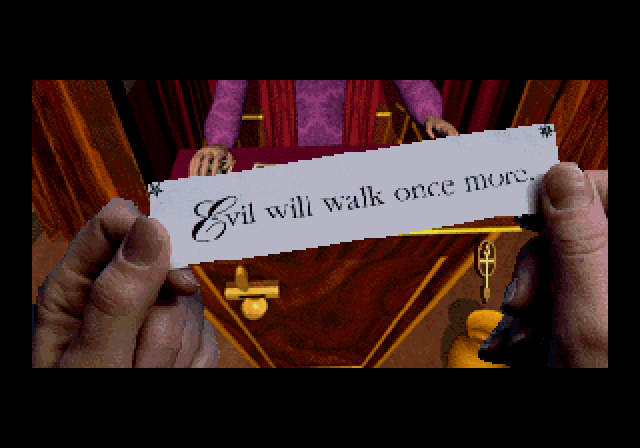
The same widescreen window is used on the Saturn, but where the PC displays a dashboard, there is nothing but black space in the Saturn port. All dashboard functions are instead accessed via the pause menu. Not a game-breaker, but a noticeable change. The cursor (cursole?) is significantly larger in the Saturn version, and although you wouldn’t think this a big deal, it actually proves distracting as it remains on-screen at all times, often obstructing the relatively small video area. You may well find yourself constantly moving the cursor out of the way as you squint to make out the details being presented in the somewhat low Saturn resolution.
Generally, any time a game is ported to a machine whose specs are significantly different from the source hardware, optimization is required to make the game look as close to the source material as possible. If the port is a quick-and-dirty, ugly artifacts tend to sneak their way in. Such is the case with Saturn Phantasmagoria. Although the FMV actors already looked somewhat unnatural on the PC when interacting with their static backgrounds – think Adrienne sitting down on a virtual couch and the couch cushions failing to deform in any way, no shadows being cast, and so on – the effect is even worse on Saturn because there is almost always a blue outline around the ported actor sprites. This artifact, probably an issue with the transfer of video from PC to Saturn, is present around nearly all objects that move on the static backgrounds. It tends to be somewhat immersion breaking. Further, the heroine is rarely up close to the camera. Often, she is a very small graphic against the background, making the blue halos that much more noticeable. Lastly, at times the static backgrounds load in faster than the video bits – the still-image counter at the town’s general store will load in a solid second faster than the FMV clerk manning it. This gives the Saturn game a very amateurish vibe.
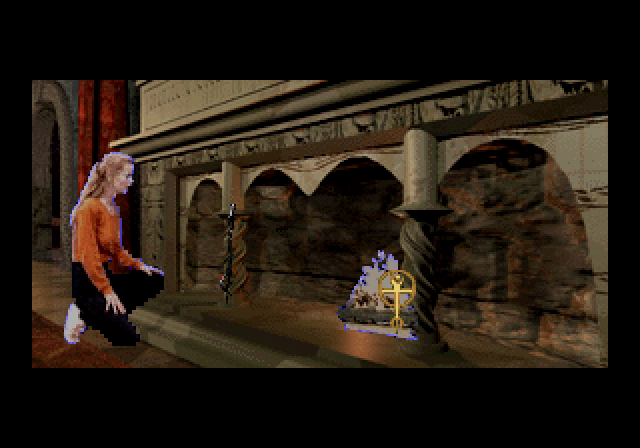
Load times between screens as Adrienne moves around her world are also just long enough to be noticeable and irritating, which tends to ruin flow. The downgrade in resolution compounds all the visual problems with the Saturn port. Store signs, letters, newspapers are all quite legible on the PC original but become a pixelated mess on Saturn. It was the same with Artus’ letter in MYST – buttery smooth on PC; illegible on Saturn. This drop in resolution impacts Adrienne’s character model as well. She ranges from passable in the more uncommon close-ups to horribly pixelated in most other cases, and not in line with the scaling of the backgrounds. It’s as if she had to be downsampled in the transfer to Saturn, and it ended up a particularly bad cross-over.
The one positive to note here is that the Saturn version supports the Shuttle / NetLink mouse. Although a standard controller works just fine, playing with a mouse gives a more authentic experience. Still, the cursor speed is adjustable regardless of control interface and can dart around at a satisfying speed in response to player input.
On the whole, the Saturn port can barely be considered competent. No optimization seems to have been applied to the Saturn version and whereas the PC original was crafted to create immersion, the Saturn port feels grafted on to ‘just work’, without any care taken to play to the SEGA system’s strengths. Further, the entire game – and this includes the PC original – feels a bit bloated. Part of the reason so many discs are required is the gratuitous FMV… but none of the discs are filled to capacity, and a significant amount of each disc’s contents repeat across all discs. The intro / demo sections, for example, are present on every single disc. Although this was how the PC original was structured as well, one can’t help but think the entire package is… inefficient.
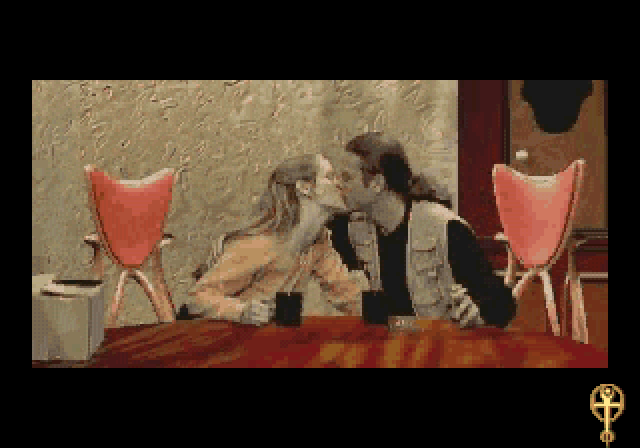

But if the game is good…
The game is somewhat polarizing. It certainly has its fans as a Sierra adventure, and as one of Roberta Williams’ most well-known works. Indeed, as a Halloween playthrough, the game deals with relatively mature content and players may well be disturbed while experiencing it, in ways few other Saturn titles achieve. Being freshly translated, it can be a very novel Halloween game to experience. However, critics of the PC original found plenty to complain about.
The story and characters, as written by the brilliant Williams, are quite solid and believable. Where things take a tumble is bringing Williams’ vision across to the videogame medium.
Story-wise, the player takes control of Adrienne Delaney, successful novelist, who with her husband Don, have purchased the mysterious old mansion. As the player guides Adrienne around, they learn that the estate initially belonged to black magic practitioner Zoltan Carnovasch, whose five successive wives all died on the estate from seemingly natural causes. Early on, the player discovers a bricked-off chapel, complete with altar, and it is here where Adrienne unwittingly releases the very demon who had been sealed off since Carno’s time in the mansion. The demon goes on to possess Don, who then begins to treat Adrienne with progressive cruelty and malice, fetishizing her beheaded. At one point, he quotes something along the lines of “a woman’s body is a beautiful thing, but the head is useless”. Will Adrienne suffer the same fate as Carno’s wives did? That’s up to the player to discover, but suffice to say that Phantasmagoria shows off some death scenes in absolutely brutal and graphic ways.
The acting quality is middling. None of it is bad per se, but none of it won Sierra any awards, either. The beginning sequence of the game sees Adrienne awaken from a nightmare and find safety in Don’s arms… who proceeds to make her feel better by having sex with her. Players are even ‘treated’ to a hint of boobage as Adrienne finds comfort moving back and forth on top of Don. None of it – not Adrienne’s terrified, shallow breathing when she snaps out of her nightmare, nor Don’s concern for his frightened wife, comes across as exceptionally well acted. As the adventure progresses, Adrienne comes off a bit airhead-ish (more on that later).
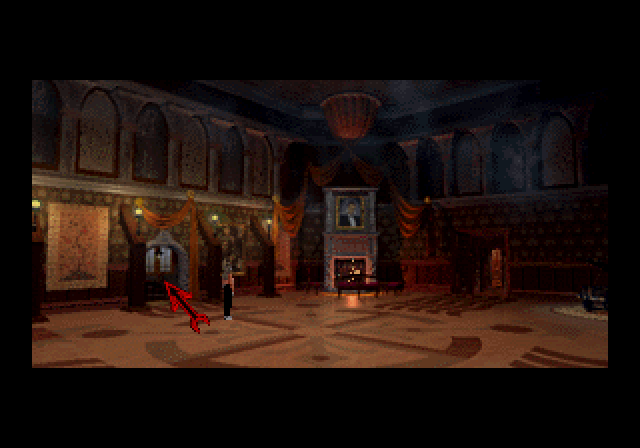
One tragic aspect of the acting seen in-game is the need for Adrienne to ‘reset’ to a neutral position after completing an action, to ‘prepare’ her for the next scene. For instance, if the player has Adrienne inspect a room, she will shuffle and poke about, and then return to a pre-marked area and face forward. This happens all through the game. Adrienne exits her car, then faces forward at attention, awaiting the player’s next command. Perhaps the director thought this would be necessary for this style of game – live-action FMV adventures were quite new at the time – but the effect comes off terribly unnatural. Whatever suspense and immersion the game hopes to weave with its ‘ultra realistic graphics’ is repeatedly shattered by these constant acting cues, reminding the player that is merely a videogame.
There isn’t much music as Adrienne makes her way through the mansion, estate, and adjoining town. Most of it is done Tomb Raider style, with nice music occasionally coming on as the player triggers an important event. The choir makes their voices heard in some of the more tense moments as well, and that aspect of the OST is grandiose. Sound effects are done quite well, matching the on-screen action and indeed helping at times, adding aural cues when the Saturn’s resolution makes it difficult to see exactly what Adrienne is interacting with.
The gameplay proper suffers from being both too easy and somewhat too obtuse. Much like all point and click adventures, there are only so many places to explore, and only so many items to interact with. The game plays well enough if the player follows the intended sequence, but should you get lost or miss a vital clue, Phantasmagoria quickly descends into a click-a-thon until you stumble upon the ‘correct’ next click. Compounding the problem somewhat is that the ‘hit boxes’ can be a bit unintuitive. Getting Adrienne to move in a way that triggers a change of background is sometimes painful. The hitbox doesn’t always cover everywhere one would think to click to get her to step off-screen and into the next scene, so even though the player may know where they want to go next, they may have to click around in a general direction before stumbling on the hit box. Ugh.
The puzzles are often exceptionally easy, but at times veer towards head-scratchingly obtuse. Early on, Don complains that the drain is clogged and there is no drain doctor solution in the home… easy, let’s drive into town and hit the general store. A bit later, Adrienne finds a false wall in a fireplace and needs an object to help break through. That’s… in real life, that object can be almost anything, so the click-a-thon begins until finding the correct object (more on THAT, later!).
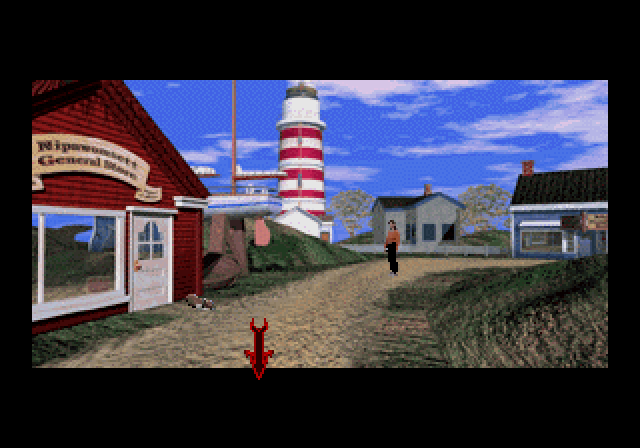
Pressing start brings up the pause screen, which features three distinct sections. At the bottom are slots for any inventory items Adrienne may have found. These items can be selected for use, replacing the cursor icon until the selected item is used in-game. In the upper right, a map of the current area displays, but frustratingly, does not show specifically where Adrienne is presently standing or which way she is oriented. This being a world of stitched-together still shots from various angles means it takes some time to get one’s bearing in a room. Finally, a large, animated, smart-assed, clue-giving skull resides in the upper left corner. A click on the creepy skull sees him blurt out what to do next… and his clues are almost always dead (har har) giveaways about what needs to be done.
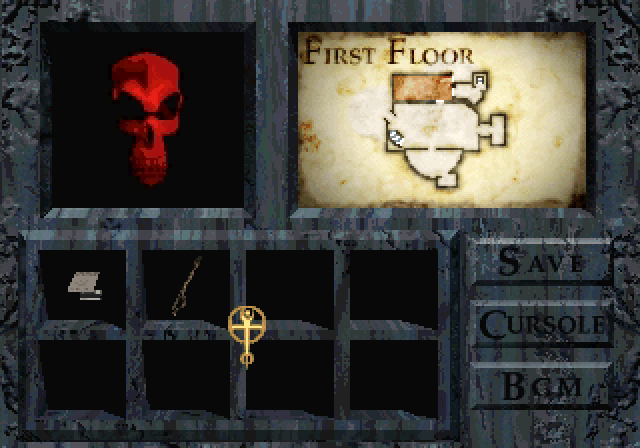
We are left with a relatively easy adventure which descends into a click-a-thon from time to time, and a relatively simple user interface for the player to contend with… or is it? Occasionally the too-easy but too-hard dichotomy really swings for the extremes. Using the aforementioned false wall to illustrate, we find Adrienne searching for an object with which to break down the soft mortar between bricks. What can she use? A sledgehammer is obvious, but there aren’t any of those around. Maybe the hot poker found near a fireplace elsewhere in the big house can be used to wedge in between bricks… as logical as that sounds, and with a poker in her inventory, this action doesn’t work. As she explores the room, Adrienne finds a small black statue on a desk near the bookshelves, but what she really needs is some kind of knife or other sharp object. The player must figure out that when the statue is selected on the inventory screen, it must be presented to the skull icon in the pause screen for Adrienne to take a close look at it, which releases a switchblade hidden within it. She can then use the switchblade to get to work on the false wall. This entire sequence is frustrating, to say the least. So the game goes, as Adrienne completes task after task, and the story unfolds.
This brings us back to the airheaded characters. This is a bit complex: the characters themselves are written well, though at times the acting falls flat or in some cases is over-exaggerated. There are times, however, where it’s just right, and it makes a huge difference in one’s enjoyment of the title. The cast of characters is varied and bizarre enough to be charming and enjoyable, and truly does makes the player want to continue to see what fate has in store for each character. In that way, it’s a bit like an Agatha Christie play – the player is never fully sure of the motives and intentions of any character. Williams’ writing has the characters swear and smoke cigarettes on occasion, all of which is fully presented to the player, adding further to the realism of a mid-90s setting. This is not something that is seen in Saturn titles at all, so it is something very fresh about the title.

Ultimately, one wonders why was this ported to Saturn at all? It’s difficult to $ay. Perhaps the Japanese house that brought the title over saw an opportunity to cash in on an American hit, infamous for its violence and gore that is depicted in real-life visuals. Porting is always quicker and cheaper than a ground-up new development, so it may have been seen as a viable proposition. There is no sales data to indicate whether the Saturn venture was a success, but the quality of the port is such that, unfortunately, one can’t help but feel this was nothing but a cash grab.
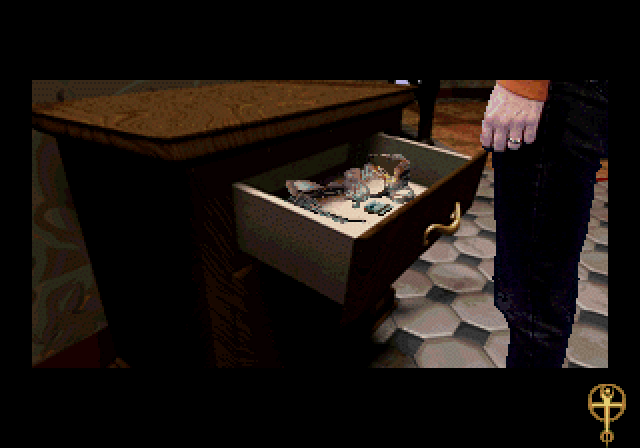
Is Phantasmagoria ultimately worthy of your time this Halloween season?
The original game is polarizing, and the Saturn iteration does nothing to dispel that polarity – if anything, the quality of the port accentuates it even more. The game’s story is quite interesting and does get genuinely frightening at times. It delves into some fairly macabre material, dealing with the occult and setting up a horrific feeling of being alone in a scary environment. There aren’t very many Saturn titles that handle this kind of subject matter with a realistic story and life-like (ahem!) graphics. The sound complements the atmosphere very nicely. The visuals, conceptually, are never worse than decent, but on a technical level, fall somewhat hard. The Saturn’s resolution makes fine details, especially print, lost to the player. The acting is average, but the many characters can and do grow on the player as they muddle their way through the adventure. The actors themselves on CG backgrounds looked OK on the PC but are somewhat cringeworthy on the Saturn owing to the change in resolution, and the blue outlines do them no favors. The segmented loading of the visuals, another Saturn-only artifact, just adds to the pain. The gameplay and interface are clearly suited to a 90s PC and not a 90s console, and though the mouse helps, the changes in layout for the Saturn just aren’t for the better.
Enjoyment of this particular Saturn title may well be confined to a narrow segment of gamers. Those that dive in will have to enjoy the fascinating story wrapped in shallow gameplay, as well as the Saturn port’s many shortcomings… but the relatively mature themes, unexpectedly charming characters, and overall story just might be enough to pull you in.
A Bizarre Connection to the Unreleased
There are a few titles in the Saturn catalogue that appear to have been prepped for release and even had at least a small batch of discs pressed, but for whatever reason, were ultimately cancelled. The Japanese edition of racing game Scorcher is one such example – the game enjoyed a wide Western release in both North America and in Europe, but no official Japanese release… but a Japanese disc, complete with disc art and a full case and manual, have been spotted in the wild.
The same year as Phantasmagoria, Sierra published an FMV-heavy first-person space shooting style visual adventure game on the PC titled The Last Dynasty. It enjoyed moderate success in Europe, but was not treated kindly by critics. The Sierra-published game remained a PC exclusive… or did it? Like Phantasmagoria, a port for the Saturn – and only the Saturn – was completed, though The Last Dynasty was never released commercially. Still, officially pressed Silvers (Saturn pre-production discs carrying the security ring but featuring no disc art at all) as well as full-art pressings are known to exist and are currently in the hands of private collectors. At present, there is no confirmation why this fully finished game was cancelled and never released.


A Saturn fan since the beginning, Peter plays Saturn almost exclusively. For Peter, Saturn represents a moment in time where 2D games were at their best, 3D was just rising, and fascinating gaming ‘firsts’ were commonplace. There are very few Saturn games that Peter cannot find some enjoyment in!


Leave a comment